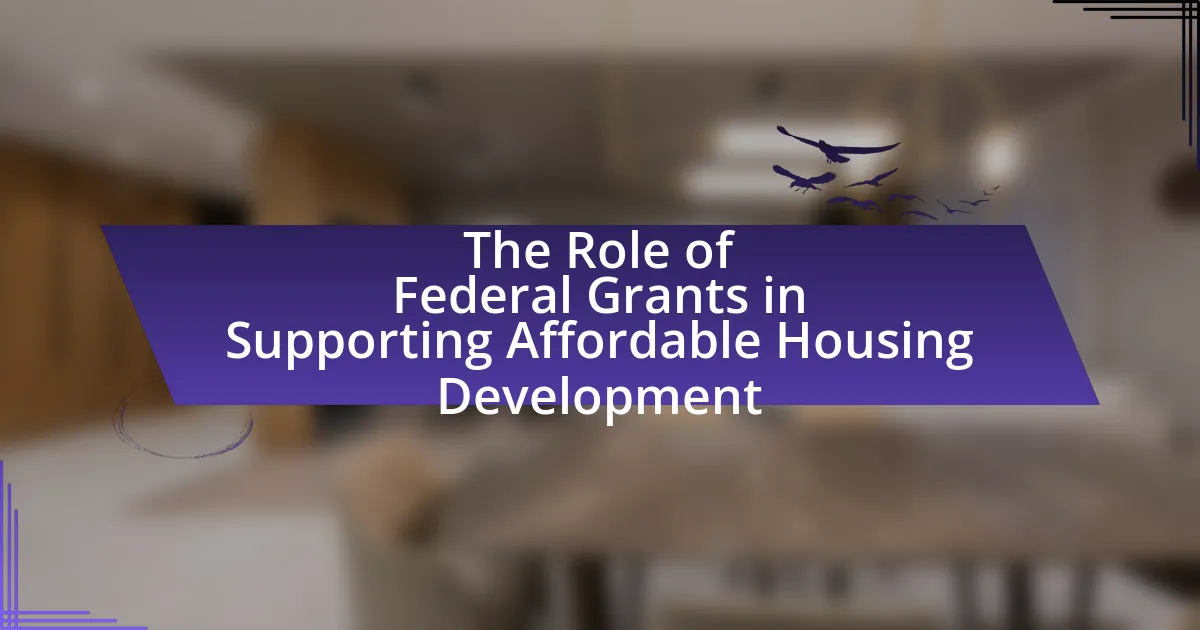Federal grants play a crucial role in supporting affordable housing development by providing financial resources aimed at constructing, rehabilitating, and preserving housing units for low-income individuals and families. Key programs such as the Community Development Block Grant (CDBG) and the HOME Investment Partnerships Program, administered by the U.S. Department of Housing and Urban Development (HUD), allocate billions annually to address housing shortages and improve living conditions. The article explores the types of federal grants available, the allocation process, the challenges developers face, and the impact of these grants on local communities and the overall housing market. Additionally, it discusses future trends, innovative approaches, and best practices for maximizing the effectiveness of federal funding in affordable housing initiatives.

What are Federal Grants and Their Purpose in Affordable Housing Development?
Federal grants are financial awards provided by the federal government to support specific projects, including affordable housing development. Their primary purpose is to facilitate the construction, rehabilitation, and preservation of affordable housing units, thereby addressing housing shortages and improving living conditions for low-income individuals and families. For instance, the U.S. Department of Housing and Urban Development (HUD) allocates billions annually through programs like the Community Development Block Grant (CDBG) and the HOME Investment Partnerships Program, which directly fund affordable housing initiatives. These grants are essential in reducing the financial burden on developers and ensuring that affordable housing projects are viable and sustainable.
How do Federal Grants function in the context of affordable housing?
Federal grants function as financial resources provided by the government to support the development and maintenance of affordable housing. These grants are typically allocated through various federal programs, such as the Community Development Block Grant (CDBG) program and the HOME Investment Partnerships Program, which aim to assist local governments and non-profit organizations in creating and preserving affordable housing options.
For instance, in 2022, the U.S. Department of Housing and Urban Development (HUD) allocated over $3 billion through the CDBG program to help communities address housing needs, including the construction of new affordable units and the rehabilitation of existing properties. This funding enables recipients to reduce housing costs for low-income families, thereby increasing access to safe and affordable living conditions.
What types of Federal Grants are available for affordable housing development?
The types of Federal Grants available for affordable housing development include the Community Development Block Grant (CDBG) program, the HOME Investment Partnerships Program, and the Housing Trust Fund (HTF). The CDBG program provides funding to local governments for a variety of community development activities, including affordable housing. The HOME program offers grants to states and localities to create affordable housing for low-income households, while the HTF specifically allocates funds to build, rehabilitate, and operate rental housing for extremely low-income families. These grants are essential for facilitating the development of affordable housing across the United States.
How are Federal Grants allocated to different housing projects?
Federal grants are allocated to different housing projects through a competitive application process managed by various federal agencies, primarily the Department of Housing and Urban Development (HUD). These agencies assess proposals based on criteria such as project feasibility, community need, and alignment with federal housing goals. For instance, in 2021, HUD awarded over $3 billion in grants through programs like the Community Development Block Grant, which supports local governments in funding housing initiatives. This allocation process ensures that funds are directed to projects that effectively address affordable housing shortages and promote sustainable development.
Why are Federal Grants essential for affordable housing initiatives?
Federal grants are essential for affordable housing initiatives because they provide critical funding that enables the development and maintenance of low-income housing projects. These grants help bridge the financial gap that often exists in affordable housing development, as private investors may be hesitant to fund projects with lower profit margins. For instance, the U.S. Department of Housing and Urban Development (HUD) allocates billions annually through programs like the Community Development Block Grant (CDBG) and the HOME Investment Partnerships Program, which directly support local governments and non-profit organizations in creating affordable housing options. This funding is vital in addressing the housing crisis, as it allows for the construction, rehabilitation, and preservation of affordable units, ultimately contributing to community stability and economic growth.
What impact do Federal Grants have on local communities?
Federal grants significantly enhance local communities by providing essential funding for various projects, particularly in affordable housing development. These grants enable local governments and organizations to undertake initiatives that improve housing accessibility, reduce homelessness, and stimulate economic growth. For instance, the U.S. Department of Housing and Urban Development (HUD) allocates billions annually through programs like the Community Development Block Grant (CDBG), which supports infrastructure improvements and housing projects. Research indicates that communities receiving federal grants experience increased job creation and improved living conditions, demonstrating the tangible benefits of such funding on local economies and social structures.
How do Federal Grants influence the overall housing market?
Federal grants significantly influence the overall housing market by providing financial resources that facilitate the development of affordable housing. These grants enable local governments and non-profit organizations to undertake housing projects that might otherwise be financially unfeasible, thereby increasing the supply of affordable units. For instance, the U.S. Department of Housing and Urban Development (HUD) allocates billions annually through programs like the Community Development Block Grant (CDBG), which directly supports housing initiatives. This influx of funding can lead to improved housing conditions, stabilization of neighborhoods, and increased property values, as seen in areas that have successfully utilized federal grants to revitalize housing stock.

What are the Challenges Associated with Federal Grants in Affordable Housing Development?
The challenges associated with federal grants in affordable housing development include complex application processes, stringent compliance requirements, and limited funding availability. These complexities often deter potential developers from pursuing federal grants, as the application process can be time-consuming and require extensive documentation. Additionally, compliance with federal regulations, such as environmental assessments and labor standards, can impose significant administrative burdens. Furthermore, the competition for limited federal funding means that many projects may not receive the necessary financial support, leading to delays or cancellations in affordable housing initiatives.
What obstacles do developers face when applying for Federal Grants?
Developers face several obstacles when applying for Federal Grants, including complex application processes, stringent eligibility requirements, and limited funding availability. The application process often involves extensive documentation and compliance with federal regulations, which can be time-consuming and challenging for developers. Additionally, many grants have specific eligibility criteria that may exclude certain projects or organizations, making it difficult for some developers to qualify. Furthermore, the competition for federal funding is intense, with many applicants vying for a limited pool of resources, which can hinder the chances of securing grants for affordable housing projects.
How can developers navigate the application process effectively?
Developers can navigate the application process effectively by thoroughly understanding the requirements and guidelines of federal grants related to affordable housing. This involves researching specific grant programs, such as the Community Development Block Grant (CDBG) or the HOME Investment Partnerships Program, which provide funding for affordable housing initiatives. Familiarity with eligibility criteria, application deadlines, and required documentation is crucial. Additionally, developers should engage with local housing authorities and attend informational workshops to gain insights and clarify any uncertainties. According to the U.S. Department of Housing and Urban Development, successful applicants often demonstrate a clear project plan, community impact, and financial feasibility, which are essential for securing funding.
What common pitfalls should developers avoid when seeking Federal Grants?
Developers should avoid several common pitfalls when seeking Federal Grants, including inadequate research on grant requirements, failing to align project goals with funding priorities, and submitting incomplete or poorly written applications. Inadequate research can lead to missed opportunities, as each grant has specific eligibility criteria and objectives that must be met. Aligning project goals with funding priorities is crucial, as grants are often awarded to projects that directly support the agency’s mission, such as affordable housing development. Additionally, incomplete or poorly written applications can result in disqualification; according to the National Council of Nonprofits, clear and compelling narratives are essential for successful grant applications.
How do Federal Grants interact with state and local funding sources?
Federal grants supplement state and local funding sources by providing additional financial resources for affordable housing development. These grants often require matching funds from state or local governments, which encourages collaboration and alignment of priorities between federal, state, and local agencies. For instance, the U.S. Department of Housing and Urban Development (HUD) offers Community Development Block Grants (CDBG) that states and municipalities can use to enhance their housing initiatives, thereby leveraging federal funds to maximize local investment in affordable housing projects. This interaction not only increases the overall funding available but also promotes a coordinated approach to addressing housing needs at multiple government levels.
What role do state and local governments play in the distribution of Federal Grants?
State and local governments are crucial in the distribution of Federal Grants, as they serve as intermediaries that allocate funds to specific projects and programs within their jurisdictions. These governments assess local needs, prioritize projects, and ensure compliance with federal guidelines, which facilitates the effective use of federal resources. For instance, the U.S. Department of Housing and Urban Development (HUD) provides Community Development Block Grants (CDBG) that state and local governments utilize to address affordable housing and community development needs, demonstrating their pivotal role in directing federal funds to local initiatives.
How can collaboration between different funding sources enhance affordable housing projects?
Collaboration between different funding sources can significantly enhance affordable housing projects by pooling financial resources, thereby increasing the overall funding available for development. When federal grants, private investments, and local government funds are combined, they create a more robust financial structure that can cover the high costs associated with affordable housing construction and maintenance. For instance, a study by the Urban Institute found that leveraging multiple funding sources can reduce the financial burden on any single entity and improve project feasibility, leading to a higher number of completed units. This collaborative approach not only maximizes available capital but also fosters innovative financing solutions, ultimately resulting in more sustainable and effective affordable housing initiatives.

What are the Future Trends in Federal Grants for Affordable Housing Development?
Future trends in federal grants for affordable housing development include increased funding for sustainable building practices, a focus on equity in housing access, and the integration of technology in housing solutions. The U.S. Department of Housing and Urban Development (HUD) has been emphasizing green building initiatives, as seen in the allocation of over $10 billion in grants for energy-efficient housing projects in recent years. Additionally, federal programs are increasingly targeting underserved communities, with initiatives like the Affirmatively Furthering Fair Housing rule aiming to reduce disparities in housing access. The incorporation of technology, such as smart housing solutions, is also gaining traction, supported by federal grants aimed at modernizing housing infrastructure. These trends reflect a strategic shift towards more inclusive, sustainable, and technologically advanced affordable housing development.
How is the landscape of Federal Grants evolving in response to housing needs?
The landscape of Federal Grants is evolving to address housing needs by increasing funding for affordable housing initiatives and prioritizing grants that support low-income communities. Recent legislative measures, such as the American Rescue Plan Act of 2021, allocated $5 billion specifically for emergency housing vouchers, reflecting a shift towards immediate assistance for vulnerable populations. Additionally, the Biden administration’s proposed budget for fiscal year 2023 includes a significant increase in funding for the Department of Housing and Urban Development, emphasizing the need for sustainable housing solutions. This evolution is driven by rising housing costs and a growing recognition of housing as a critical component of public health and economic stability.
What innovative approaches are being adopted in the use of Federal Grants?
Innovative approaches being adopted in the use of Federal Grants include the implementation of performance-based funding models and the integration of technology for streamlined application processes. Performance-based funding models incentivize grantees to achieve specific outcomes, thereby enhancing accountability and effectiveness in the use of federal funds. For instance, the U.S. Department of Housing and Urban Development (HUD) has increasingly focused on metrics that measure the success of affordable housing projects, ensuring that grants are allocated to initiatives that demonstrate tangible results. Additionally, technology integration, such as online platforms for grant applications and management, has simplified the process, making it more accessible for applicants and reducing administrative burdens. These approaches not only improve efficiency but also foster innovation in affordable housing development.
How might policy changes affect the availability of Federal Grants in the future?
Policy changes may significantly reduce the availability of Federal Grants in the future. For instance, shifts in federal budget priorities or changes in administration can lead to decreased funding for specific grant programs, as seen in past budget proposals that aimed to cut funding for housing assistance programs. Additionally, new regulations or eligibility criteria could limit access to grants for certain organizations or projects, impacting the overall distribution of funds. Historical data shows that during the 2010 budget cuts, many affordable housing initiatives faced funding reductions, illustrating how policy decisions directly influence grant availability.
What best practices should developers follow when utilizing Federal Grants?
Developers should adhere to several best practices when utilizing Federal Grants to ensure effective and compliant use of funds. First, they must thoroughly understand the specific requirements and guidelines associated with each grant, as these can vary significantly between programs. For instance, the U.S. Department of Housing and Urban Development (HUD) provides detailed criteria for its grants, which include eligibility requirements and reporting obligations.
Second, developers should engage in comprehensive planning and budgeting to align project goals with grant objectives, ensuring that all expenditures are justifiable and within the scope of the grant. This is crucial because mismanagement of funds can lead to penalties or loss of funding.
Third, maintaining clear and consistent communication with grant administrators is essential. This practice helps in addressing any questions or concerns promptly and ensures compliance with all reporting and documentation requirements.
Finally, developers should implement robust monitoring and evaluation processes to track project progress and outcomes, which can provide valuable insights for future grant applications and demonstrate accountability to funding agencies. These practices collectively enhance the likelihood of successful grant utilization and contribute to the overall effectiveness of affordable housing development initiatives.
How can developers ensure compliance with grant requirements?
Developers can ensure compliance with grant requirements by thoroughly understanding the specific terms and conditions outlined in the grant agreement. This involves reviewing all documentation provided by the granting agency, including eligibility criteria, reporting obligations, and allowable expenses. Additionally, developers should implement a robust project management system that tracks compliance milestones and deadlines, ensuring that all activities align with the grant’s stipulations. Regular communication with the grantor can also provide clarification and guidance, helping to address any potential issues proactively. According to the U.S. Department of Housing and Urban Development, adherence to these practices significantly reduces the risk of non-compliance and enhances the likelihood of successful project outcomes.
What strategies can maximize the impact of Federal Grants on affordable housing projects?
To maximize the impact of Federal Grants on affordable housing projects, strategic collaboration among stakeholders is essential. Engaging local governments, non-profit organizations, and private developers fosters a comprehensive approach that leverages diverse resources and expertise. For instance, the U.S. Department of Housing and Urban Development (HUD) emphasizes the importance of public-private partnerships, which can enhance project viability and sustainability. Additionally, aligning grant applications with community needs and demonstrating measurable outcomes can significantly increase funding success rates. Research indicates that projects with clear, data-driven goals are more likely to receive federal support, as evidenced by HUD’s focus on performance metrics in grant evaluations.



